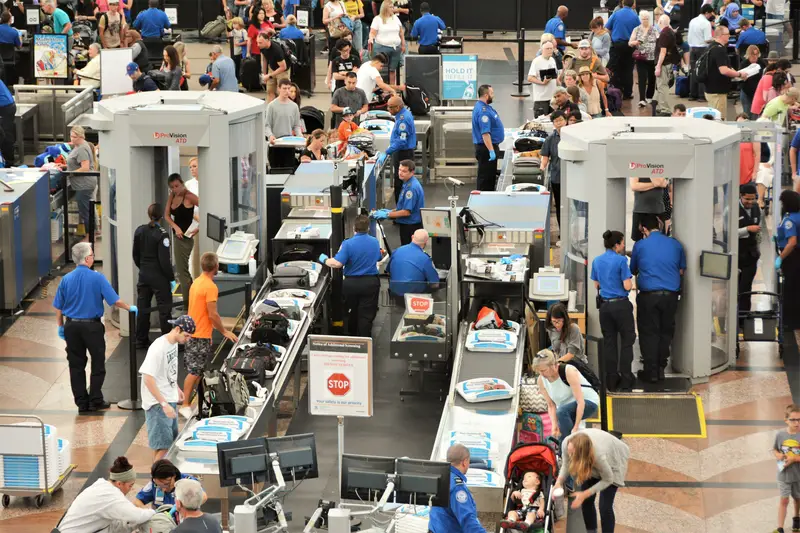Most travelers assume they know what can and can’t go through airport security, but recent TSA warnings suggest otherwise. The Transportation Security Administration recently issued comprehensive guidance on food and drink items after countless passengers faced confiscation surprises at checkpoints. Understanding these rules could save time, money, and the embarrassment of having favorite snacks tossed in the trash right before boarding.
Liquid rules are more confusing than expected
The infamous 3-1-1 rule catches more travelers off guard than anticipated. Liquids must be in containers of 3.4 ounces or less, fit in a single quart-sized clear bag, and passengers can only carry one such bag. What surprises many is how broadly TSA defines “liquids.” Items like peanut butter, honey, maple syrup, and even hummus fall under this category. Many travelers pack these items without realizing they need to follow liquid restrictions.
Creamy spreads and sauces create the most headaches at security checkpoints. Salad dressing, ketchup, jam, jelly, and gravy must all comply with the 3.4-ounce rule when carried in hand luggage. Ice cream, yogurt, and liquid chocolate also count as liquids, regardless of their consistency. Even cheese spreads get flagged, while solid cheese blocks pass through without issue. The key distinction lies in whether the item can be poured, squeezed, or spread at room temperature.
Alcohol has strict limitations most people ignore
Mini bottles of alcohol can travel in carry-on bags, but only if they’re 3.4 ounces or smaller and fit in the liquids bag. However, passengers cannot consume any personal alcohol during the flight unless served by flight attendants. Alcoholic beverages with 24 percent alcohol or less face no restrictions in checked luggage, making wine and beer relatively easy to transport. Stronger spirits between 24 and 70 percent alcohol content are limited to 5 liters per passenger in checked bags and must remain in unopened retail packaging.
The most severe restriction applies to high-proof alcohol exceeding 140 proof or 70 percent alcohol content. Items like grain alcohol and 151 proof rum are completely banned from both carry-on and checked luggage. Duty-free alcohol purchases present another exception – these can exceed 3.4 ounces in carry-on bags if kept in tamper-evident bags with receipts proving purchase within 48 hours. Mini bottles remain popular for travelers who understand these nuanced rules.
Baby items require special handling procedures
Parents traveling with infants must inform TSA officers at the beginning of screening when carrying formula, breast milk, or baby food exceeding 3.4 ounces. These items need separate screening from other belongings, and officers may test liquids for security purposes. The process moves faster when baby items are clearly labeled and easily accessible. Parents should expect additional time at checkpoints and arrive earlier than usual to accommodate these extra steps.
TSA recommends transporting formula and breast milk in clear, translucent bottles rather than plastic bags or pouches. This packaging choice speeds up the screening process and reduces the likelihood of additional testing. Baby formula containers and puree pouches are allowed in any quantity, making them exempt from standard liquid restrictions. Water and juice for babies also receive special treatment, though parents must remove these items for separate screening regardless of container size.
Frozen foods need perfect timing to pass
Fresh meat, seafood, and frozen foods are permitted in both carry-on and checked luggage, but only when completely frozen during screening. If ice packs have melted or food has thawed, TSA treats these items as liquids subject to the 3.4-ounce rule. This timing challenge means travelers must carefully plan their arrival at the airport to ensure frozen items remain solid. Many discover this rule too late when their carefully packed frozen goods get confiscated at security.
Ice packs used to keep food frozen are allowed but must be completely frozen when passing through security. Gel ice packs that have partially melted become problematic, as TSA considers them liquids. Gel ice packs work best for maintaining temperature, but travelers need backup plans if these items thaw before screening. Smart travelers use dry ice alternatives or ship frozen items separately to avoid security complications entirely.
Solid foods generally pass without problems
Most solid food items travel freely in both carry-on and checked luggage. Crackers, nuts, cookies, bread, candy, and cereal face no restrictions regardless of quantity. Cooked meat without liquid, sandwiches, pizza, and even whole rotisserie chickens are welcome on flights. These items rarely cause delays at security checkpoints, making them ideal choices for travelers who want to avoid complications. Fresh fruits and vegetables also pass through domestic security without issues.
Baked goods like donuts, cakes, and pies travel well and make popular gifts for destination visits. TSA specifically mentioned that donuts with any toppings are acceptable, showing their flexibility with solid foods. Travel snacks in sealed packages work particularly well for long flights. The main consideration with solid foods involves international travel, where agricultural restrictions may apply differently than domestic TSA rules.
Canned goods trigger additional screening steps
Canned foods are allowed in checked luggage without restrictions, but carry-on transport requires extra screening. TSA officers may need additional time to examine canned items because of how they appear on X-ray machines. The dense contents and metal packaging can obscure security screening, leading to manual inspection. Travelers should expect delays when packing canned goods in carry-on luggage and consider alternative packaging when possible.
Some canned items may not pass through checkpoints despite being technically allowed. Security concerns or screening difficulties could result in items being rejected, even when they appear on the permitted list. Canned goods work better in checked luggage where they won’t cause screening delays. TSA suggests shipping canned items to destinations or leaving them at home when carry-on space is limited.
International travel adds agricultural restrictions
Domestic flights within the United States allow most fresh fruits and vegetables, but international travel introduces agricultural concerns. Passengers flying from Hawaii, Puerto Rico, or the U.S. Virgin Islands to the mainland face restrictions on fresh produce due to invasive plant pest concerns. These rules exist separately from TSA security requirements and focus on protecting agricultural interests rather than flight safety.
International travelers must declare all food, plant, and animal products to avoid fines or additional questioning. One passenger recently faced an $800 fine over a single apple that wasn’t declared properly. Agricultural inspectors use dogs trained to detect prohibited items, making it nearly impossible to hide restricted foods. Declaration forms must be completed honestly to avoid penalties that far exceed the value of confiscated items.
Live animals require airline coordination
Live lobsters are technically permitted by TSA in both carry-on and checked luggage, but airlines set their own policies about live animal transport. Passengers must check with specific airlines before attempting to travel with live seafood or other animals. Most airlines have strict requirements about containers, documentation, and handling procedures for live cargo. The TSA approval represents only one hurdle in a complex process involving multiple regulations.
MREs (Meals Ready to Eat) also require airline approval despite TSA permission. These military-style meals contain chemical heating elements that concern some airlines, even when TSA considers them safe for transport. MRE meals work well for camping trips and emergency preparedness, but travelers should confirm airline policies before packing them. The lesson applies broadly – TSA approval doesn’t guarantee airline acceptance of unusual items.
Planning ahead prevents checkpoint disasters
Smart travelers research food restrictions before packing and consider shipping questionable items separately. TSA’s comprehensive online guide covers hundreds of specific items, making it easy to check individual foods before travel. Labeling and organizing food items in carry-on bags speeds up screening when additional inspection is required. Clear containers and proper packaging demonstrate cooperation with security personnel and reduce screening time.
Backup plans work better than hoping restricted items will pass through security. Travelers can pack questionable items in checked luggage, ship them to destinations, or simply leave them at home. Travel containers designed for airport security help organize allowed items efficiently. The few minutes spent planning food transport can save hours of delays and the frustration of losing favorite items at security checkpoints.
These TSA warnings exist because food-related security delays happen daily at airports nationwide. Understanding the rules before arriving at the airport prevents unpleasant surprises and keeps travel plans on schedule. The key lies in recognizing that food restrictions often depend on consistency, alcohol content, and packaging rather than the food type itself.

